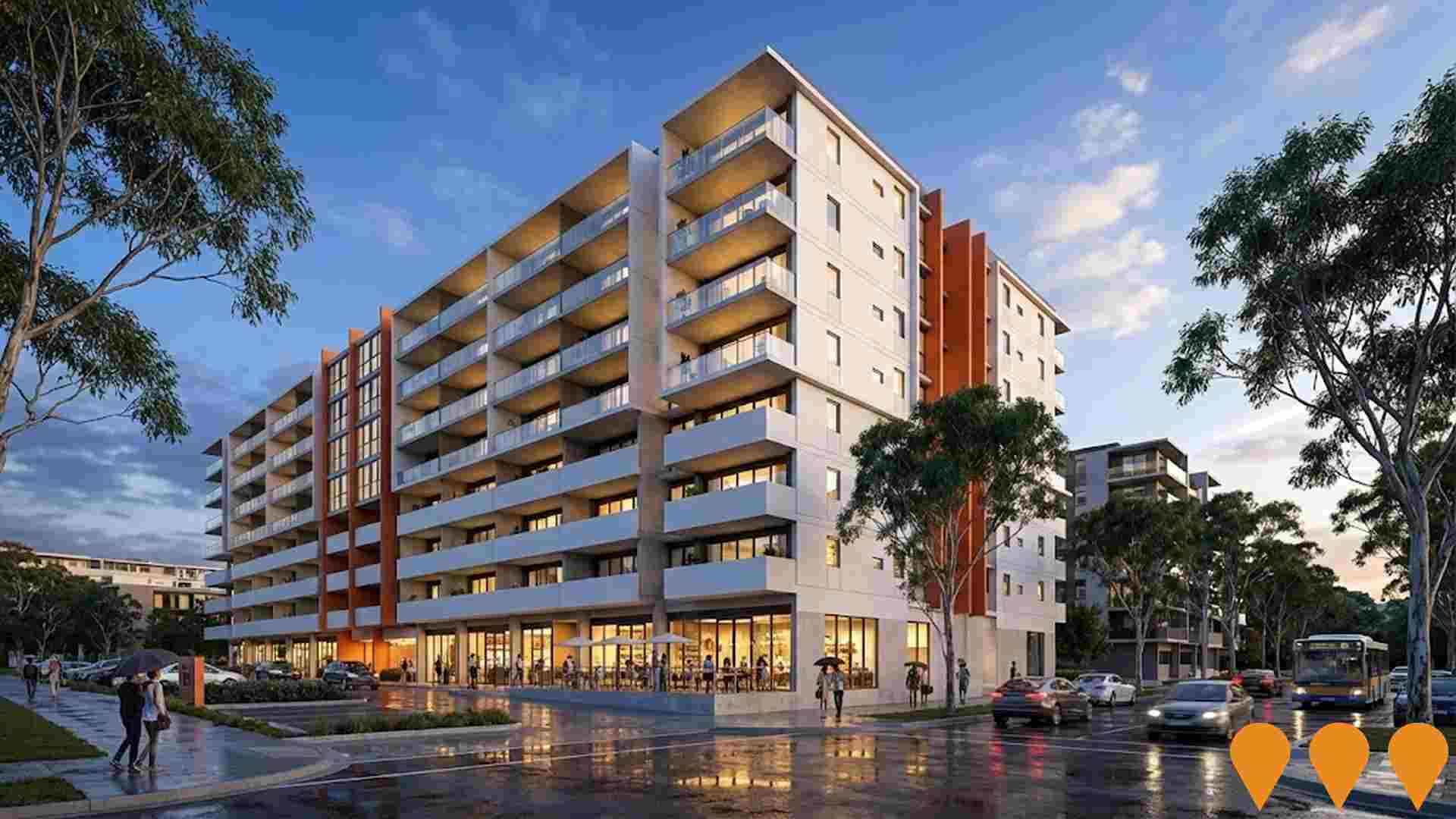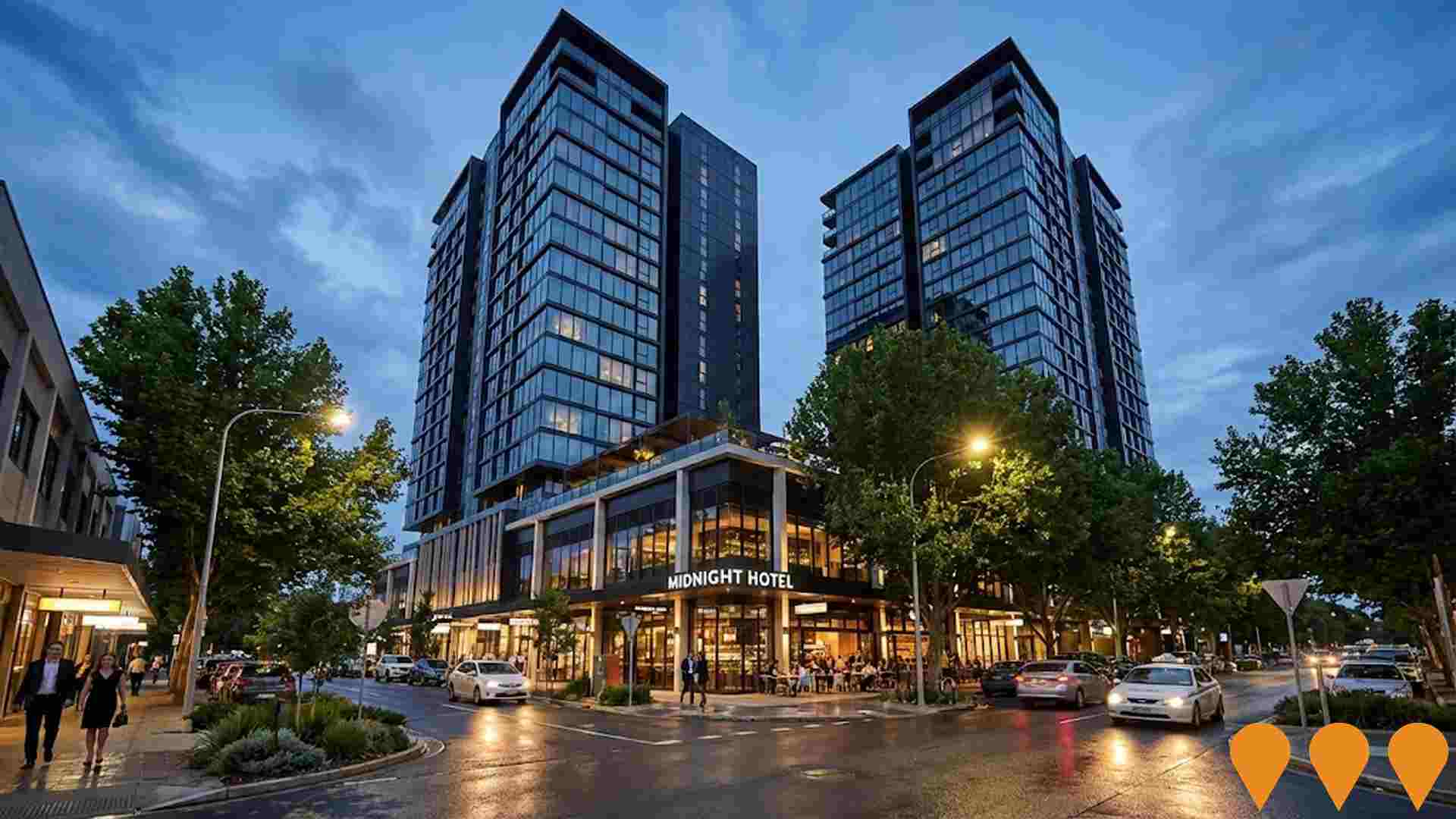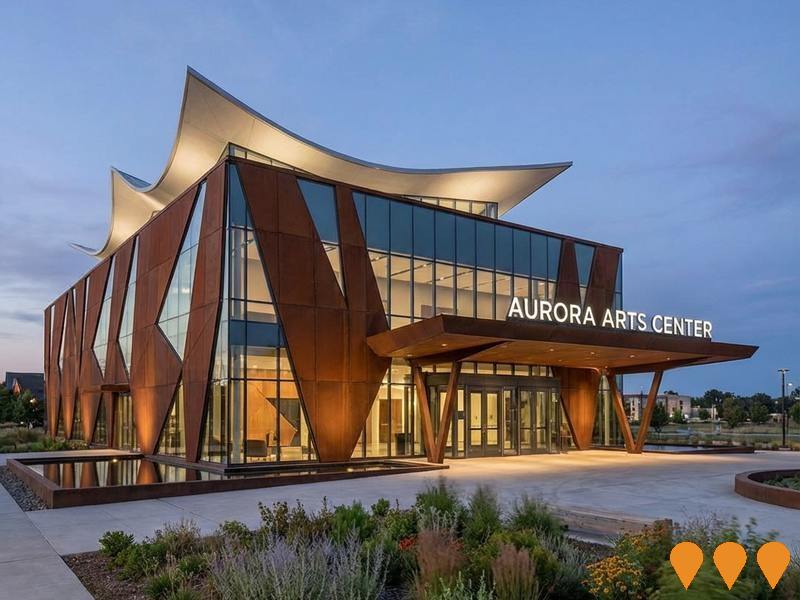Chart Color Schemes
est. as @ -- *
ABS ERP | -- people | --
2021 Census | -- people
Sales Activity
Curious about local property values? Filter the chart to assess the volume and appreciation (including resales) trends and regional comparisons, or scroll to the map below view this information at an individual property level.
Find a Recent Sale
Sales Detail
Population
Acton lies within the top quartile of areas nationally for population growth performance according to AreaSearch analysis of recent, and medium to long-term trends
Acton's population was around 3,279 as of August 2025. This reflected an increase of 431 people since the 2021 Census, which reported a population of 2,848 people. The change was inferred from the estimated resident population of 3,279 from the ABS as of June 2024 and address validation since the Census date. This level of population equated to a density ratio of 1,196 persons per square kilometer. Acton's growth of 15.1% since the 2021 census exceeded the state average of 5.7%. Population growth for the area was primarily driven by overseas migration.
AreaSearch adopted ABS/Geoscience Australia projections for each SA2 area, released in 2024 with a base year of 2022. For areas not covered and years post-2032, age group growth rates from the ACT Government's SA2 area projections were used, also based on 2022. Future population trends forecasted a significant increase in Acton's top quartile national statistical area population by 1,094 persons to 2041, recording a gain of 33.4% over the 17 years.
Frequently Asked Questions - Population
Development
The level of residential development activity in Acton is very low in comparison to the average area assessed nationally by AreaSearch
Development activity data is being compiled for this area.
Relative to the Australian Capital Territory, Acton records markedly lower building activity. This constrained new construction usually reinforces demand and pricing for existing properties. This activity is likewise lower than nationally, reflecting market maturity and pointing to possible development constraints.
Frequently Asked Questions - Development
Infrastructure
Acton has strong levels of nearby infrastructure activity, ranking in the top 40% nationally
The performance of an area is significantly influenced by changes in local infrastructure, major projects, and planning initiatives. AreaSearch has identified a total of 22 projects that are expected to impact the area. Notable projects include ACT Light Rail Stage 2A (City to Commonwealth Park), Parkes Way Upgrade, Ikon Place - Section 19 Braddon, and ANU Kambri Precinct. The following list details those projects likely to be most relevant.
Professional plan users can use the search below to filter and access additional projects.
INFRASTRUCTURE SEARCH
 Denotes AI-based impression for illustrative purposes only, not to be taken as definitive under any circumstances. Please follow links and conduct other investigations from the project's source for actual imagery. Developers and project owners wishing us to use original imagery please Contact Us and we will do so.
Denotes AI-based impression for illustrative purposes only, not to be taken as definitive under any circumstances. Please follow links and conduct other investigations from the project's source for actual imagery. Developers and project owners wishing us to use original imagery please Contact Us and we will do so.
Frequently Asked Questions - Infrastructure
ACT Light Rail Stage 2A (City to Commonwealth Park)
The 1.7km extension of Canberra's light rail from Alinga Street to Commonwealth Park is **under construction** and expected to be operational in **early 2028**. It will feature **three new stops** at Edinburgh Avenue, City South, and Commonwealth Park. The project includes wire-free operation with on-board energy storage systems, a new light rail bridge over Parkes Way, and integrated cycling and walking infrastructure. Enabling works, including the raising of London Circuit, are also underway. The project is jointly funded by the Australian and ACT Governments and is being delivered as an augmentation to the Stage 1 Public-Private Partnership (PPP) agreement with the Canberra Metro consortium. The total major works contract is valued at $577 million.

Ikon Place - Section 19 Braddon
Proposed mixed-use precinct on Section 19 Braddon delivering up to 650 apartments across multiple towers with retail and public realm improvements.

Midnight - Section 22 Braddon
A landmark mixed-use precinct comprising two towers delivering 398 apartments, hotel rooms (Midnight Hotel), retail, dining and the Midnight Bar on the former Motor Registry site in central Braddon.

Zarah
Zarah is a boutique development of 11 three- and four-bedroom townhouses at 60-62 MacLeay Street, Turner. The design focuses on contemporary inner-north living with options for rooftop terraces, elevator, double basement garages, private courtyards and multiple balconies.

Botanical Turner
A multi-stage residential development on the CBD gateway in Turner, designed by SJB and developed by Amalgamated Property Group with Base Developments. Stage 1 is underway on Northbourne Avenue, with a display suite on site and apartments now selling. Architecture features a sculptural white crown above terracotta and brick, with landscaped courtyard and resident amenity.

Parkes Way Upgrade
A long-term vision to upgrade the Parkes Way corridor, potentially including lowering sections of the road to better connect the city to Lake Burley Griffin. This is part of the broader 'City to the Lake' initiative.

ANU Kambri Precinct
The redevelopment of the Australian National University's Union Court into a vibrant precinct called Kambri. The project includes new teaching and learning facilities, student accommodation, a health and wellbeing centre, a cinema, retail spaces, and new public spaces, including an amphitheatre.

Acton Waterfront (Ngamawari)
A major urban renewal project to connect Canberra's city to Lake Burley Griffin, featuring a new public park named Ngamawari with an adventure playground, artworks, native gardens, event spaces, and a new boardwalk. The project aims to create a vibrant waterfront destination with improved public spaces, recreational opportunities, and a future residential and commercial neighbourhood. The interim park is open, with the permanent park due for completion in 2028.

Employment
AreaSearch analysis of employment trends sees Acton performing better than 85% of local markets assessed across Australia
Acton has a highly skilled workforce with significant representation in essential services sectors. Its unemployment rate is 0.6%, lower than the Australian Capital Territory's (ACT) 3.4%.
Employment growth over the past year was estimated at 2.0%. As of June 2025, there are 2,211 residents employed with an unemployment rate of 2.8%, below ACT's rate. Workforce participation is lower at 57.9% compared to ACT's 69.6%. Employment is concentrated in accommodation & food, education & training, and retail trade.
Acton specializes in accommodation & food employment, with a share 4.4 times the regional level. Conversely, public administration & safety has limited presence at 4.5%, compared to the region's 30.4%. There are 2.6 workers per resident, indicating Acton functions as an employment hub attracting workers from surrounding areas. Between June 2024 and June 2025, employment increased by 2.0% while labour force grew by 1.7%, reducing the unemployment rate by 0.3 percentage points. In contrast, ACT experienced employment growth of 1.9% with a 0.3 percentage point drop in unemployment. Jobs and Skills Australia's national employment forecasts for May 2025 project national employment expansion at 6.6% over five years and 13.7% over ten years. Applying these projections to Acton's employment mix suggests local growth of approximately 5.9% over five years and 12.3% over ten years, though these are simple weighted extrapolations for illustrative purposes only.
Frequently Asked Questions - Employment
Income
Income metrics place the area in the bottom 10% of locations nationally according to AreaSearch analysis
Acton's median taxpayer income in financial year 2022 was $17,264, with an average of $24,701 according to postcode level ATO data aggregated by AreaSearch. This is lower than the national average, contrasting with the Australian Capital Territory's median income of $68,678 and average income of $83,634. Based on Wage Price Index growth of 13.6% since financial year 2022, Acton's estimated median income as of September 2025 would be approximately $19,612, with an average of $28,060. Census income data is not available for detailed analysis in Acton. The earnings profile shows that the predominant cohort spans 0% of locals (0 people) in the $0 - $399 category, contrasting with the metropolitan region where the $1,500 - $2,999 bracket leads at 34.3%.
Frequently Asked Questions - Income
Housing
Acton displays a diverse mix of dwelling types, with ownership patterns similar to the broader region
Acton's dwelling structures, as per the latest Census, consisted entirely of houses (0.0%) with no semi-detached dwellings, apartments, or other types recorded. This is unlike the Australian Capital Territory which had 39.3% houses and 60.7% other dwellings. Home ownership in Acton was 0.0%, indicating all dwellings were either mortgaged (0.0%) or rented (0.0%). The median monthly mortgage repayment in Acton was $0, significantly lower than the Australian Capital Territory average of $2,080 and the national average of $1,863. The median weekly rent figure in Acton was recorded at $9, substantially below both the Australian Capital Territory figure of $476 and the national average of $375.
Frequently Asked Questions - Housing
Household Composition
Acton has a typical household mix, with a lower-than-average median household size
Family households constitute 0.0% of all households, including 0.0% couples with children, 0.0% couples without children, and 0.0% single parent families. Non-family households comprise the remaining 100.0%, with lone person households at 0.0% and group households making up 0.0%. The median household size is 1.0 people, which is smaller than the Australian Capital Territory average of 2.2.
Frequently Asked Questions - Households
Local Schools & Education
Acton faces educational challenges, with performance metrics placing it in the bottom quartile of areas assessed nationally
The area's university qualification rate is 30.7%, significantly lower than the SA3 area average of 59.7%. Bachelor degrees are most common at 18.5%, followed by postgraduate qualifications (11.4%) and graduate diplomas (0.8%). Technical qualifications account for 7.1% of educational achievements among residents aged 15+, with advanced diplomas at 2.1% and certificates at 5.0%. Educational participation is high, with 97.6% of residents currently enrolled in formal education.
This includes 97.2% in tertiary education, 0% in primary education, and 0% pursuing secondary education. Educational facilities seem to be located outside the immediate catchment boundaries, requiring families to access schools in neighboring areas.
Frequently Asked Questions - Education
Schools Detail
Nearby Services & Amenities
Transport
Transport servicing is good compared to other areas nationally based on assessment of service frequency, route connectivity and accessibility
Analysis shows 11 active public transport stops in Acton, all providing bus services. These stops are served by 16 different routes, together offering 3,973 weekly passenger trips.
On average, there are 567 trips per day across all routes, which amounts to approximately 361 weekly trips per stop.
Frequently Asked Questions - Transport
Transport Stops Detail
Health
Acton's residents boast exceedingly positive health performance metrics with a range of health conditions having marked impacts on both younger and older age cohorts
Acton's health outcomes show significant results across various conditions affecting both younger and older age groups. Private health cover rate is extremely low at approximately 44% of the total population (~1,436 people), compared to 65.3% in Australian Capital Territory and a national average of 55.3%. Mental health issues and asthma are the most common conditions, affecting 15.6 and 9.9% of residents respectively.
74.9% of residents report no medical ailments, compared to 70.8% across Australian Capital Territory. The area has 0.3% (8 people) of residents aged 65 and over, lower than the 11.4% in Australian Capital Territory. Health outcomes among seniors require more attention than the broader population.
Frequently Asked Questions - Health
Cultural Diversity
Acton was found to be more culturally diverse than the vast majority of local markets in Australia, upon assessment of a range of language and cultural background related metrics
Acton's population showed high cultural diversity, with 31.6% born overseas and 24.3% speaking a language other than English at home. Christianity was the predominant religion in Acton, comprising 23.1%. However, Judaism stood out at 1.8%, significantly higher than the Australian Capital Territory's average of 0.5%.
The top three ancestral groups were Australian (25.2%), English (21.7%), and Other (10.6%). Some ethnic groups had notable divergences: Hungarian was overrepresented at 0.5% compared to the regional figure of 0.3%, South African at 0.8% versus 0.3%, and Russian at 0.5% against 0.4%.
Frequently Asked Questions - Diversity
Age
Acton hosts a very young demographic, ranking in the bottom 10% of areas nationwide
The median age in Acton is 21 years, which is significantly younger than the Australian Capital Territory's average of 35 years and Australia's average of 38 years. In comparison to the Australian Capital Territory average, the 15-24 age group is notably over-represented at 86.1% in Acton, while the 35-44 age group is under-represented at 2.2%. This concentration of individuals aged 15-24 is well above the national average of 12.5%. Between 2021 and present day, the median age has increased by 1.9 years from 19 to 21, indicating an aging population. During this period, notable shifts include the 5-14 age group growing from 0.0% to 1.4%, and the 0-4 cohort increasing from 0.2% to 1.5%. Conversely, the 15-24 age group has declined from 88.1% to 86.1%, and the 25-34 age group decreased from 9.4% to 7.5%. By 2041, Acton's population is expected to see significant shifts in its age composition. The 15-24 age cohort is projected to expand by 847 people (30%) from 2,823 to 3,671, while the 85+ age group is projected to grow by a modest 0% (0 people).

